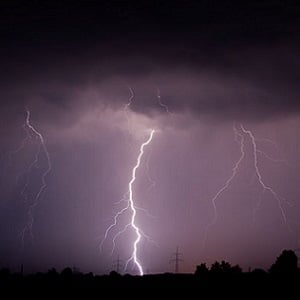
Lightning is probably the most underrated natural hazard. Thunderstorms occur frequently over large parts of South Africa, especially in summer in the north and during winter in the south, and death and injury from lightning strikes are not uncommon.
What can you do to protect yourself? Get indoors
You don't want to be outside in an electrical storm. Always check the weather forecast before planning any outdoor activity.
If you are outside when the storm approaches, get into a building, or failing that, a vehicle, as soon as possible.
Don’t hesitate and wonder when to make a move. If you see lightning, hear thunder or even see dark storm clouds overhead, that’s the time to get indoors. Some weather experts recommend the following test: if the time between a lightning flash and corresponding thunder clap is less than 30 seconds, the storm is dangerously close.
But rather don’t stand around counting – get inside.
The best place to be during a thunderstorm is inside a formal structure with solid walls and roof – tents will offer no protection, and car ports, open garages, covered patios, sheds and greenhouses aren't sufficient either.
It's good if the building also has proper plumbing and electricity: if lightning strikes directly, the electrical current will typically travel through the wiring and/or plumbing, and then into the ground.
This is why you should avoid anything in the building connected to the plumbing system (e.g. sinks, baths) or electric system (e.g. plug sockets, corded telephones, electrical appliances).
Any metal conductor exposed to the outside could become a lightning conduit and therefore must not be touched.
Don't watch lightning from open windows or doorways. Stay inside until at least 30 minutes after the last clap of thunder.
Vehicles and lightning
If there's no safe building to take shelter in, second-best option is an enclosed, metal-sided and metal-roofed vehicle. (Open vehicles like a convertible or the back of a bakkie, and cars with fibreglass or plastic shells, won't provide sufficient protection.) Once inside, as with a building, avoid contact with conductors to the outside.
Close the windows, lean away from the door, and don't touch the steering wheel, ignition, gear stick or radio. If you’re driving when a thunderstorm hits, stop and pull over if you can, or at least slow down. Stay in the vehicle and observe the 30-minute rule.
When you can’t get indoors
If you get caught outside, take action to reduce the risk of being struck: Lightning tends to strike the highest object in the area, so stay away from isolated trees and telephone poles. A high percentage of lightning fatalities are caused by people trying to shelter from the storm under a tree. If you’re in a forest, stay near a lower stand of trees. Avoid wide-open exposed areas, hilltops and rocky outcrops; get down to a lower elevation if you can.
Remember, a tent offers no protection from lighting. Stay away from water, wet items and metal objects like wire fences, as these are excellent conductors of electricity. Make yourself the smallest, lowest possible target. This is best done by assuming the “lightning position”: squat with your feet together, tuck in your head and cover your ears.
Don't huddle in a group – keep a couple of body lengths between people. That way, if one person gets hit, there is a less chance of the charge spreading to the others.
When someone is struck by lightning
Call for emergency medical help. Being struck by lightning can have a devastating effect on the body, including major burns, nervous system damage, loss of hearing and eyesight, and broken bones.
Do CPR if the person has stopped breathing.
Read: CPR for the untrained bystander
Unlike someone electrocuted by a continuous current, someone who has been struck by lightning carries no electrical charge and can be touched.
The best place to be in a thunderstorm is in a solid, properly-earthed building. Flimsy structures like tents offer no protection.
When indoors:
- Don't use any equipment that's directly connected to electric current or fed from the outside, such as computers, televisions or corded telephones.
- Stay away from plumbing, such as faucets, sinks and bathtubs.
- Don't hang out on the stoep. Come inside and stay away from doors and windows.
- Don't lean against a concrete wall or lie on a concrete floor.
The second-best option is a stationary vehicle with metal sides and roof (the metal shell formed by the car helps deflect the electrical charge). Close the windows; lean away from the door; don't touch the steering wheel, ignition, gear lever or radio. Stay in the vehicle at least 30 minutes after the last thunder-clap.
If you're caught outside in a thunderstorm far from suitably protective buildings or vehicles, avoid the following:
- High, exposed areas
- Tall, isolated structures like trees and telephone poles
- Metal structures like fences
- Water.
If the lightning's right overhead, assume the "lightning position / crouch": squat with feet together, head tucked in, ears covered. Don't huddle in a group – spread out.
Read more:




 Publications
Publications
 Partners
Partners













